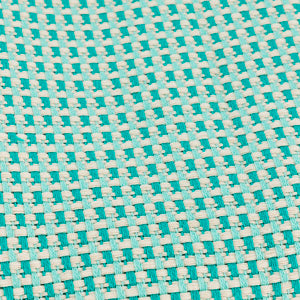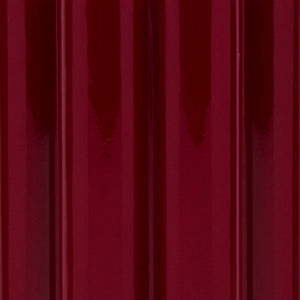Family
A Former Lamp Factory in Belgium Has Been Transformed Into a Loft With a Modernist Spirit and Scenography that Honours the Memphis Movement
At
Hélène Rebelo and Édouard Beauget
What if the secret of successful interior design was simply to free yourself from codes and genres? A free and intuitive approach to the design of our living spaces that we at The Socialite Family adhere to in the same way as Hélène Rebelo. For this self-taught woman – who has been living in Brussels for three and a half years with her video artist companion and collaborator Édouard – understanding home design means “enjoying a meeting of eras” without taking herself too seriously. In this former lamp factory renovated into a 130m2 loft with modernist accents, this jack-of-all-trades orchestrates, under the amused eye of her partner, a universe that is “undeniably colourful but also sensitive, warm, optimistic, and whimsical”. “A sort of interior garden” where green subtly reveals the richness of its nuances from the floor – with the carpet designed by the thirty-year-old in partnership with the artisans of Stitch Rugs – to the walls and its seats that are dotted with our bold cushions. A fan of 1970s and 1980 prolific production lines, Hélène is a collector of flagship creations by notable designers from the Memphis movement – such as the avant-garde Ettore Sottsass – alongside exceptional finds that her discerning eye spotted at flea markets. An unconditional love of second-hand goods stemming from childhood and her parents – a resourceful and optimistic couple who inspire her on a daily basis – and that she cultivates with her other half, who is also for this ecological and economic consumerist approach. Driven by an incredible desire to make sense of her work, the young woman now shares her love of objects and spaces with a greater number of people. Through curating designer pieces and working in interior decoration. A taste of the confident scenography where poetry and humour combine to form a “graphic, fine, geometrical and clear” message that Edouard also shares. A couple that revels in the pleasure of working together and (re)discovering beautiful things together.
Location
BRUSSELS
Author
Juliette Bruneau
Photos and videos
Valerio Geraci
TSF
Hélène and Édouard, can you introduce yourselves?
Hélène et Édouard
We are a couple of creative types who make a good team and complement each other – in our work and private life. We have been together for twelve years and both come from Loir-et-Cher where we met. We’ve lived in Brussels for three and a half years, it’s a city that inspires us and boosts our creativity.
TSF
What are your backgrounds?
Hélène
I’ve always been creative and a dreamer, I never really felt like I belonged, either in school or in my previous jobs. After secondary school, I tried my hand at various things: a content writer for a start-up, I then studied cosmetics for three years and became an artistic make-up artist while also continuing my studies. Add to this my experience as a sales consultant for the luxury market as well as a fashion columnist for a local TV channel… I needed to find meaning in my work, so aged 25, I left my last job to start my own business. After doing a business creation course, I founded Cool Machine, supported and assisted by Édouard. It was an online store dedicated to emerging artists and designers from around the world for which I also curated the works. Cool Machine was a way for me to use my own “naive” eye, to get into the design industry without any formal education. Seven years of running my business have educated my eye thanks to a multitude of ultra-contemporary young talents who I discovered. But I gradually became a bit frustrated with Cool Machine: I needed to satisfy my creativity another way. So I have recently moved into interior design, which allows me to combine my passion for vintage furniture with my love of ultra-contemporary design. As well as sourcing for my private/professional clients, I’m also a consultant on various projects and am currently working on my very first job as a decorator.
Édouard
After leaving secondary school, and not being able to go away to study, I did a Diploma in Communication. I then began to develop an interest in image work and website development. I’m currently working on obtaining a professional licence in audiovisuals. My TV script career started in Tours, or rather as a production assistant-editor-operator-video-director because in local TV everyone does a bit of everything – you learn a lot! In addition to my official role as a scriptwriter, I love editing; I occasionally have the pleasure of working as a director. At the same time, Hélène and I started developing Cool Machine and that confirmed my need for independence. So I resigned from my full-time position and moved into temp work! When I don’t have a contract, I work with Helen. I shoot the products and edit the photos, I develop process execution to save us time so that Hélène can devote herself to the more creative e-shop part. There is still a strict work rhythm, but it’s fun. Seven years later, we decided to put Cool Machine on the back burner. But thanks to Hélène’s talent, and her ability to draw attention to her aesthetics and visual compositions, we are working together on different orders to create photo and video content for various brands, while I also work on my TV contracts.
TSF
Tell us about your upbringing. In what environment did you grow up – and how did that affect your ideas of what constitutes beauty?
Hélène
I don’t like talking about beauty as such – it is intimately linked to the one who is observing it. During my upbringing, I would find beauty where others might not see it… Edward and I grew up in very modest families who lived in small villages. We didn’t get to travel much or visit museums. One thing we have in common is we both spent lots of time with our respective parents going to flea markets. We both grew up learning about the advantages of second-hand goods, such as economic and ecological reasons, but also for the pleasure of bargain-hunting and coming across unexpected finds. One important part of my upbringing was having the freedom to choose and try what interests me. My parents never let me think that something wasn’t right for me, it was more about the will and desire to try something out. My dad’s family fled a dictatorship and arrived in France when he was 9. It took him time and a lot of perseverance to build his life in France. His optimism and strength of character have always been, and still are, the main inspiration behind my self-taught career. If I were to link my job as a decorator and my education, it would be seeing my parents take great care of their home. I grew up in a colourful interior and DIY was very much a part of this.
Édouard
I come from a background where no one was really interested in art. I started to be aware of it as well as the graphics quite late on. I remember an art history teacher during the first year of my diploma who would captivate me with fascinating stories about different paintings or photos. He always talked about moods and feelings, rather than techniques; I think that’s what affects me the most when I’m in front of a work. Ditto for when I watch a film or video. I always remember the story behind images more than how they were created, even though my background is a technical one. You could say that Hélène is my ‘art teacher’ thanks to everything she shares with me or offers me. I may or may not like what I see, but I still often get influenced by it! (Laughs)
TSF
Hélène, you are a set designer, decorator, a design object curator but also behind the Cool Machine project. Tell us about your relationship with design and objects.
Hélène
Being self-taught gives me great freedom. I’ve only recently begun to appreciate this opportunity. I let myself be inspired and influenced by my daily discoveries… I always picked the craftspeople and designers for Cool Machine and that’s still the case in my current work. Today, Cool Machine is no longer, but I am deeply committed to continuing to work in partnership with ultra-contemporary artists. I love being able to mix their creations with vintage or antique furniture. Right from the start, I’ve loved to blend eras while bringing a certain consistency. I’m just at the start of my interior design adventure, but I hope to work on projects with a wide range of people. I’m already learning heaps from my first customers, who sometimes take me to levels I don’t expect to go, and I love the feeling.
TSF
In a few words, how would you describe your visual universe?
Hélène
Undeniably colourful but also sensitive, warm, optimistic, fanciful… I need to be surrounded by objects with a strong identity. I pay attention to colours and shapes. I also like sculptural objects that are functional but also remarkable in other ways. I love it when curved lines, roundness and thickness are combined with graphic, fine, geometric and sharp shapes. I’m moved by the juxtaposition between poetry and humour when blending materials and fun shapes. I’m not keen on decor that takes itself too seriously. Overall, I’m highly influenced by 1970-1980 and by Italian design! I also adore the work of the decorator Mary Gilliatt, and I own several of her books. I love Charlotte Taylor’s work and worked with her for a long time through Cool Machine, and I’m also a fan of Zyva Studio, Uchronia World, ODA, Claude Cartier, Casa Josephine, Jean Philippe Demeyer, Dimore, Studio Giancarlo Valle, Andrés Gutiérrez… Equally, I draw inspiration from the work of the architect Luis Barragán, drawings by Nathalie du Pasquier, Pedro Almodovar’s films and photographs by Paul Rousteau…
TSF
You both left France three years ago for Brussels. Why did you make the move?
Hélène
We’ve always lived in provincial areas, close to nature. We wanted a livelier cultural life, but we’re a very quiet couple and couldn’t see ourselves living in a buzzing city like Paris, for example… We visited Brussels at the very beginning of our relationship and loved the vibe. It’s a small capital city. We’ve found the same calm and simplicity of human relationships that we had in Tours, but with a very rich cultural life. Not having had the opportunity to travel for our studies, we felt the need to embark on this “long-term journey” in Belgium, without moving too far from France and our loved ones.
TSF
You settled down in an old lamp factory. How did you discover this place?
Hélène
Our move to Brussels was quick. We found our first apartment here within a couple of days and back then didn’t have the time to explore all the possibilities; we didn’t know much about the city’s different areas. Once we’d settled into our new life, we looked elsewhere. We found this loft on a specialist website. It was the first and only loft we visited. It was in the middle of the pandemic, the former tenant was only using it as a studio to produce their paintings, and she hadn’t used it for a year. When we visited it, it was almost empty. We were charmed by the volume and 130 m2 size (we’d always lived in homes that were 70 m2 max), the ceiling is 3.50 m high, it has huge industrial windows, the bricks are painted white and the modernist feel of the wood structure meant we could separate the main room from the master suite while benefiting from lots of storage space. We were immediately inspired by the cubic shape of the kitchen and bathroom. We’re lucky to have a landlord who lets us feel fully at home here.
TSF
What was the common thread when decorating the different areas?
Hélène
When we arrived, we only had very small items of furniture, adapted to our old homes. We had to look at things from a different perspective. The starting point was the piece by the artist Julie Lansom and our set of Orsay chairs by Gae Aulenti for Knoll that we definitely wanted to keep. Their green wool guided our early ideas, it is the defining colour in our main room. We had fun with a wide range of greens: from grass green to almond green and forest green. We wanted to create a kind of indoor garden and I designed the carpet with the craftspeople at Stitch Rugs which contributes greatly to the theme. Its long woollen fabric warms the flat, which at first glance isn’t that obvious in an industrial loft with a concrete floor. We then added a few touches of stitched colours here or there, including Julie’s piece. You’ll find pink with the Donut pouffe by Sabine Marcelis for Hem, and the yellow mirror by Laurène Guarneri provides the golden hour that we miss here and accentuates the indoor-outdoor idea… Most of our furniture is second-hand. We have a lot of furniture with curved shapes and smooth materials like plexiglass, metal, lacquered wood… We chose to combine materials and create contrast with stone and concrete such as our old flower pots which are in their original condition, the pink travertine on the cube from Talka, ceramics and raw wood in our small decorative objects… On the other hand, we opted for very warm colours in our master suite. We wanted to create a darker and more comforting space with the pieces we use, yet still very much inspired by the 1970s and 1980s. Most of our furniture came with us when we moved into our apartment. The Plona armchair by Giancarlo Piretti for Castelli was my very first designer purchase, found at a neighbour’s, who is the daughter of collectors, when we lived in Tours. Roger Lecal’s Lipstick mirror was found by my dad, who spent around €50 on it at the time. We also found a yellow Donut light and a September Rose stool by Axel Chay, a young designer whom I’ve followed right from the start and whom I particularly love. There is also a painting by Juliette Dubois, a Brussels artist!
The Memphis movement means a lot to me, it was kind of my gateway into the world of design. Ettore Sottsass and Nathalie du Pasquier were the first two artists to inspire me (...)
TSF
There are several Memphis movement items in your apartment. What inspires you about this design trend?
Hélène
The Memphis movement means a lot to me, it was kind of my gateway into the world of design. Ettore Sottsass and Nathalie du Pasquier were the first two artists to inspire me, especially during my time at Cool Machine. It’s a movement that freed itself from traditional norms. Their creations embody great freedom of expression and a counter-current, I was immediately touched by this fun and humorous approach to design. Instagram gives me the opportunity to work with fantastic companies like Made in Design; all our Memphis pieces come from their shop, I love their selection which is vast.
TSF
Which places in Brussels do you recommend?
Hélène
For a coffee break, I recommend Mok, Bouche or Cup28. Also taking a walk in the Marolles district and the Place du Jeu de Balle for its daily flea market, then there’s Watteeu and Via Antica for the visual pleasure. You’ll find a great selection of on-trend clothes at Icon. If you’re looking for ultra-contemporary designer pieces, head to Maniera and Shak Gallery. You’ll find loads of great restaurants and galleries in Ixelles. Go to Pêle-Mêle and you can browse through the old books. Finally, the forest of La Cambre is ideal for a long Sunday afternoon walk and the Kiosk hidden in the trees is the place to stop for a hot chocolate in the middle of winter… There are so many other fantastic places to visit in Brussels! You really should explore the city on foot, every neighbourhood has its little gems.
TSF
Where will we find you in the coming months?
Hélène
In Paris at Back of the House where I’ll be decorating their offices. I’m working in partnership with the two founders of the agency, Thomas Warren and Anne-Sophie Prévot, an inspired and inspirational duo! But also with my nose in the first book from the American magazine Sight Unseen which comes out in mid-November! Then on Instagram where I share my vintage findings, my professional projects and my inspirations, and on www.helenerebelo.com where you can contact me for all your decor projects.
)
)
)
)
)
)
)
)
)
)
)
)
)
)
)
)
)
)
)
)
)
)
)
)
)

























)